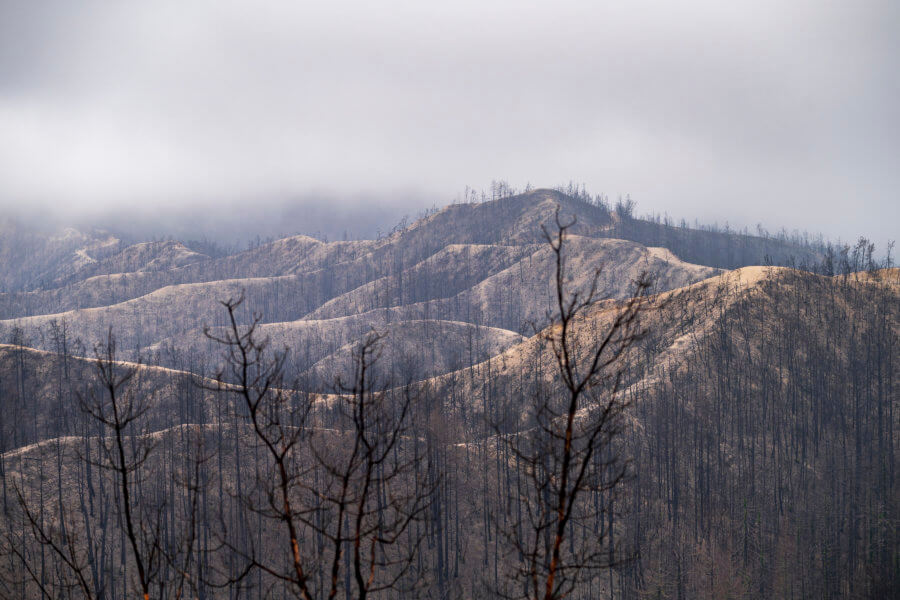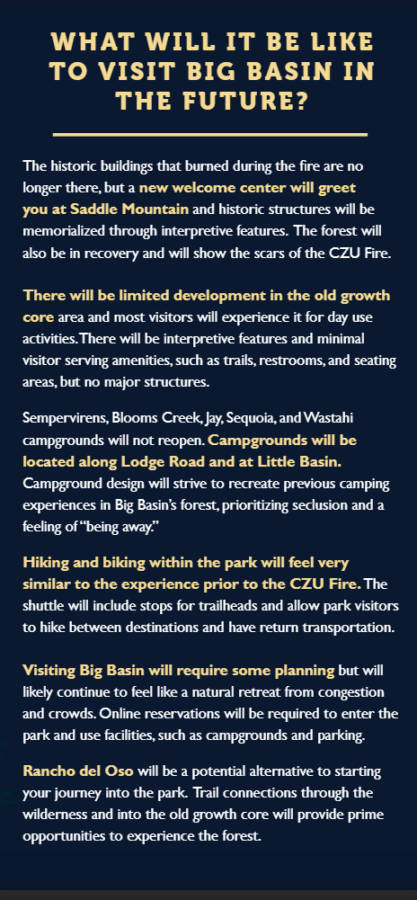Reimagining Big Basin

Damage from the 2020 CZU Lightning Complex Fire is seen at Big Basin Redwoods State Park in Boulder Creek, Calif., Friday, April 23, 2021. (AP Photo/Nic Coury)
These Redwoods Are Too Big for Small Dreams
Almost two years ago, as wildfire smoldered in Big Basin Redwoods State Park, we attempted to answer a tough question we were being asked repeatedly: what will the park look like in the future?
At the time, we didn’t yet know the extent of the damage to the forests themselves, but we did believe the moment was big: an opportunity for California State Parks to reimagine, not just Big Basin, but how all state parks are cared for, how structures are built and services are delivered, and how people are invited to experience the natural wonders of the state’s parks.
Here’s what we suggested at the time:
We aspire for a new Big Basin that honors its historic past and is designed for the future. Big Basin should be:
- Built to last. The rebuilding of Big Basin and the replacement of historic buildings will be a direct response to the lightning sparks that started this recent conflagration. New infrastructure should be light on the land and designed to be resilient and safe when these forests burn again, and again and again.
- Planned for fire. We can build resilience to climate change and wildfire into both our infrastructure and our forest. Fire management practices should be a feature of park management, based on both the best available science and also the traditional Indigenous knowledge that has been ignored for far too long.
- Co-existing with nature AND people. In meeting this moment, Big Basin can, and should, demonstrate how we can coexist successfully with other species. New park planning must reflect how deeply the park is interconnected with the surrounding landscape and nearby communities.
- Safe and welcoming for everyone. Big Basin is a great place to model new recreational experiences that are inclusive and welcoming to all people, reflecting the diversity of our communities and cultural traditions that value nature above all else.
We still believe this. And now we know that while 97% of the park burned, and almost every structure was lost, and most Douglas firs succumbed to the fire, most redwoods—98% by the most optimistic estimates—survived and will recover. That’s quite simply amazing.
Reimagining Big Basin
In August 2021, a year after the CZU fire, California State Parks launched Reimagining Big Basin, a visioning process for Big Basin's future. Hundreds of people joined meetings, attended workshops, completed surveys, and shared memories, to help California State Parks establish new strategies to guide the park's future.
And now, we, like you, are reacting to California State Parks’ Reimagining Big Basin Vision Summary, which culminates nearly a year of public and advisory input and visioning. Among the key perspectives reflected in this summary are the following strategies to meet the guiding principles for the reestablished park:
Locating visitor parking and buildings outside the old growth and providing a shuttle
- Within the old growth designing for resiliency, ecological process, and natural experience
- Relocating some camping experiences outside the core of old growth area
- Managing visitor use throughout the park to minimize congestion and to provide variety of experiences
- Increasing the inclusive and diverse storytelling
- Pursuing partnerships to create indigenous ceremonial space and indigenous land stewardship
- Managing natural resources at a landscape scale, informed by indigenous knowledge and scientific understanding
- Designing facilities based on sustainability and resiliency
- Increase trail experiences by restoring the trail network and by pursuing new trail access
What comes next?
California State Parks is opening a small portion of the park to the public this summer. They will also formally update the park’s general plan, clarifying how the park will be managed to preserve the park’s natural features, where operations and infrastructure will be sited, how the environmental and climatic conditions and cultural history of the park will be taught and interpreted, and of course, what experiences visitors can enjoy, and how.
But planning for the park’s future will now happen at the same time we can experience the park as it recovers from wildfire. For this, we are most grateful.
We’ve gotten a lot of questions about the Reimagining Big Basin vision, and the work to come.
Read on to hear our perspective on this moment:
What is the most important thing Sempervirens Fund is taking away from this summary?
Redwoods are too big for small dreams. Reimagining Big Basin is ambitious, and it prioritizes the oldest trees in the park, now and into the future. It is paramount to protect the oldest forests so they can recover, thrive once more, and continue to establish the healthy forests of the future.
Importantly, these strategies reestablish Big Basin as a park destination much sooner than we expected, but how people can access these areas and enjoy them will continue to evolve in future phases of planning. Please remember, we are on nature’s timeline, and the park’s mission is to preserve the park in a state of nature. This forest will outlive us all, especially if we let it.
Are you satisfied with the vision summary, the public process, and the strategies?
California State Parks set out to accomplish an ambitious amount of recovery and planning work in a relatively short time. Hundreds of people contributed direct feedback to State Parks over several months while State Parks staff worked feverishly to remove dangerous and hazardous conditions and to establish safe access to the park’s Eastern-most core. The Reimagining Big Basin vision establishes important strategies that allow Big Basin to safely open to the public, sooner than we expected, protect and preserve old growth, reimagine how, where, and why park infrastructure might be rebuilt in the future, and how visitors might experience the park in new, educational, and inspiring ways.
In particular, the approach to manage the land not just within the parks boundaries, but in the context of a magnificent regional system of ecosystems, is absolutely necessary and new for State Parks to consider. And their commitment to include Indigenous leadership and expertise in informing management and interpretive strategies is long overdue.
But there is a lot of work ahead to develop a full and clear new master plan, for things, like structures, and parking and transit, and for conservation management. And it is unclear how much it will all cost. While the work to date has been well funded by the state and with support from donors to organizations like ours, we know that the current funding won’t cover the work to come. California’s Governor and Legislature should be setting aside funds right now so as not to delay the important work to come. This is especially critical in the face of climate-fueled crises like drought and wildfire which are making conditions uncertain.
What’s missing?
There are many details, including timing and costs, to determine, and that will come through updating the master plan, starting later this year. And we encourage State Parks to bring in as many voices as possible to help shape up how these strategies are implemented. But ultimately what’s missing is a clear commitment from the State of California in funding the work to come.
What will this cost?
This plan envisions ambitious new designs, infrastructure, and experiences. New buildings, critical road upgrades, improved wastewater treatment facilities, new and reestablished trail networks, and a shuttle system will require investment, now and into the future. We believe it will cost a minimum of $250 million. The fire and the pandemic have been a stark reminder that parks matter. We should not delay funding reestablishing Big Basin and the scale of investment should match what this park, these forests and future visitors deserve.
You own land around Big Basin, including the recently protected Gateway to Big Basin, which is adjacent to where the park is establishing its new base of operations. What will happen with those lands, and does the Reimagining Big Basin vision change how you value these properties?
We continue to work with California State Parks on how ensure that properties protected for Big Basin, before or after the 2020 CZU fire, are added to the park as soon as possible. Now would be an ideal time to bring all the properties into Big Basin’s boundaries permanently. The Gateway to Big Basin, for example, can enhance visitor experiences, the ecological health of the park—including a seed bank of Douglas firs lost in the park—relieve pressure on the park’s new base of operations, and buffer the Boulder Creek community from park activities. We are hopeful that we can come to resolution soon, especially now that the work for Reimagining Big Basin has concluded.
More to Explore
- Read more about how Nature Needs Time to Heal
- Listen to California State Parks' Chris Spohrer introduce Reimagining Big Basin
- Learn more about the Gateway to Big Basin
 Locating visitor parking and buildings outside the old growth and providing a shuttle
Locating visitor parking and buildings outside the old growth and providing a shuttle
